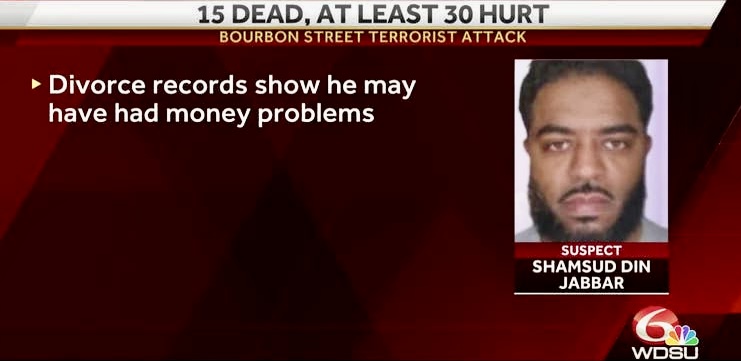What fact about the New Orleans killer was suppressed?
Questions asked by a journalist of other journalists about the terror attack in New Orleans.:

First, yes, enough is known by now to call it “terror.”
My first question is why almost every news report identified the attacker as a U.S. Army veteran.
He was. That is true. How relevant is that?
In the AP story I read Thursday morning, he was not identified by name, Shamsud-Din Bahar Jabbar, until the ninth paragraph, after naming two witnesses, President Joe Biden, and the New Orleans’ police chief.
Isn’t the Who one of the first of the journalistic 5 Ws?
The answer may be, well, his name doesn’t mean much. I ask, and his service record does?
Why did news agencies find his military service to be more relevant than his failed real estate business, his money problems, or his status as a divorced dad, all of which might have contributed to his mental state.
Not to mention his religion, which was fastidiously not mentioned.
I had to hunt for any reportage on that, and finally found it not in the New York Post, but in The New York Times:”
“Shamsud-Din Bahar Jabbar appeared to be living a quiet but dutiful life of work and faith amid Houston’s sprawling diversity: a veteran of the U.S. Army who studied information technology, converted to Islam and recently held a six-figure job.”
The AP story I mentioned did not have a word about his faith.
Is that less relevant than his military service?
Yes, yes, I know — the fear that reporting his religion might somehow fan islamophobia.
It might. Does that provide justification for withholding a salient fact? And, yes, given his proven infatuation with ISIS, it is a salient fact.
For the past generation, a woke wind has been blowing through newsrooms. Another example is the failure of most news outlets to refer to illegal immigrants as illegal. That is an announced policy, saying use of the word somehow stigmatizes migrants. No, it stigmatizes illegal migrants, who earned the stigma.
Right now, many big city, which is to say Democrat-run, newspapers have banned running the photos of criminal suspects except in rare circumstances.
Why? Because in big cities the perpetrators of violent crime are usually Black. Running the photos could lead to racist thoughts, the journalists believe.
It might.
But their job isn’t to imagine readers’ reactions. It is to present relevant facts.
Is race relevant? Often yes.
Here’s a relevant reason why suppressing the photos is a mistake.
In this social media age, the pictures get out anyway, and many readers will feel their newspaper is manipulating the news, which leads to further disrespect of the print media.
The closest parallel I can think of is Bernie Madoff, the millionaire convicted of embezzling more millions, from fellow Jews.
Madoff’s name is identifiably Jewish, and the media was not shy about reporting that most of his victims were Jewish.
His prosecution, and conviction, played into the anti-Semitic trope that Jews are unscrupulous money grubbers.
Should the story have been suppressed?
No.
And I took great delight in eviscerating Madoff in a column condemning him as a shanda (a disgrace) on Jews.
Trying to protect evil-doers is short-sighted. It is counterproductive. Put all the cards on the table.



